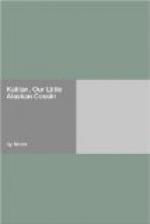“Rather an expensive pup!” commented Ted. “But what about the seals, daddy?”
“You seem to think I am an encyclopedia on the seal question,” said his father. “There is not much else to tell you.”
“How can they manage always to kill the right ones?” demanded Ted.
“The gay bachelor seals herd together away from the rest and sleep at night on the rocks. Early in the morning the Aleuts slip in between them and the herd and drive them slowly to the killing-ground, where they are quickly killed and skinned and the skins taken to the salting-house. The Indians use the flesh and blubber, and the climate is such that before another year the hollow bones are lost in the grass and earth.”
“What becomes of the skins after they are salted?”
“They are usually sent to London, where they are prepared for market. The work is all done by hand, which is one reason that they are so expensive. They are first worked in saw-dust; cleaned, scraped, washed, shaved, plucked, dyed with a hand-brush from eight to twelve times, washed again and freed from the least speck of grease by a last bath in hot sawdust or sand.”
“I don’t wonder a sealskin coat costs so much,” said Ted? “if they have got to go through all that performance. I wish we could have seen the islands, but I’d hate to see the seals killed. It doesn’t seem like hunting just to knock them on the head. It’s too much like the stock-yards at home.”
“Yes, but it’s a satisfaction to know that it’s done in the easiest possible way for the animals.
“What a lot you are learning way up here in Alaska, aren’t you, son? To-morrow we’ll be at Nome, and then your head will be so stuffed with mines and mining that you will forget all about everything else.”
“I don’t want to forget any of it,” said Ted. “It’s all bully.”
CHAPTER X
IN THE GOLD COUNTRY
A low sandy beach, without a tree to break its level, rows of plain frame-houses, some tents and wooden shanties scattered about, the surf breaking over the shore in splendid foam,—this was Teddy’s first impression of Nome. They had sailed over from St. Michael’s to see the great gold-fields, and both the boys were full of eagerness to be on land. It seemed, however, as if their desires were not to be realized, for landing at Nome is a difficult matter.
Nome is on the south shore of that part of Alaska known as Seward Peninsula, and it has no harbour. It is on the open seacoast and catches all the fierce storms that sweep northward over Bering Sea. Generally seacoast towns are built in certain spots because there is a harbour, but Nome was not really built, it “jes’ growed,” for, when gold was found there, the miners sat down to gather the harvest, caring nothing about a harbour.
Ships cannot go within a mile of land, and passengers have to go ashore in small lighters. Sometimes when they arrive they cannot go ashore at all, but have to wait several days, taking refuge behind a small island ten miles away, lest they drag their anchors and be dashed to pieces on the shore.




